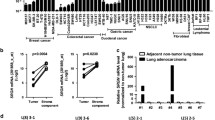Abstract
CCL19/chemokine receptor 7 (CCR7) has been found to be associated with tumor growth, angiogenesis, invasion, and lymph node metastasis. Our previous study demonstrated that CCR7 overexpressed in non-small cell lung cancer (NSCLC) and had close relationship with tumor invasion and lymph node metastasis. However, the molecular mechanism of CCR7 promoting invasion of human NSCLC cells is still unclear. In this study, we demonstrated that human lung adenocarcinoma A549 cells treated with recombinant human CCL19 could obviously upregulate the expression of Sp1 and heparanase at both the mRNA and protein levels. After blockage of CCR7, Sp1 and heparanase expressions were inhibited. Following inhibition of Sp1, heparanase expression was downregulated. The analysis showed the promoter region of heparanase gene containing a number of potential sp1 binding sites (5′-GGGGC-3′). Chromatin immunoprecipitation analysis demonstrated that Sp1 could bind to the heparanase promoter. Cell invasion assays showed that the invasion ability of A549 cells was increased with CCL19 incubation compared to the control cells. These results suggested that CCL19/CCR7 may upregulate the expression of heparanase via Sp1 and contribute to the invasion of A549 cells.





Similar content being viewed by others
References
Keeleya EC, Mehradb B, Strieter RM. Chemokines as mediators of tumor angiogenesis and neovascularization. Exp Cell Res. 2011;317(5):685–90.
Iijima N, Yanagawa Y, Clingan JM, Onoé K. CCR7-mediated c-Jun N-terminal kinase activation regulates cell migration in mature dendritic cells. Int Immunol. 2005;17(9):1201–12.
Nagira M, Imai T, Yoshida R, Takagi S, Iwasaki M, Baba M, et al. A lymphocyte-specific CC chemokine, secondary lymphoid tissue chemokine (SLC), is a highly efficient chemoattractant for B cells and activated T cells. Eur J Immunol. 1998;28(5):1516–23.
Ding Y, Shimada Y, Maeda M, Kawabe A, Kaganoi J, Komoto I, et al. Association of CC chemokine receptor 7 with lymph node metastasis of esophageal squamous cell carcinoma. Clin Cancer Res. 2003;9(9):3406–12.
Vlodavsky I, Goldshmidt O, Zcharia E, Atzmon R, Rangini-Guatta Z, Elkin M, et al. Mammalian heparanase: involvement in cancer metastasis, angiogenesis and normal development. Semin Cancer Biol. 2002;12(2):121–9.
Ilan N, Elkin M, Vlodavsky I. Regulation, function and clinical significance of heparanase in cancer metastasis and angiogenesis. Int J Biochem Cell Biol. 2006;38(12):2018–39.
Tang Z, Yu M, Miller F, Berk RS, Tromp G, Kosir MA. Increased invasion through basement membrane by CXCL7-transfected breast cells. Am J Surg. 2008;196(5):690–6.
Yadav BS, Sharma SC, Singh R, Singh G, Kumar V. Postmastectomy radiation and survival in patients with breast cancer. J Cancer Res Ther. 2007;3(4):218–24.
Wang W, Goswami S, Lapidus K, Wells AL, Wyckoff JB, Sahai E, et al. Identification and testing of a gene expression signature of invasive carcinoma cells within primary mammary tumors. Cancer Res. 2004;64(23):8585–94.
Wang W, Wyckoff JB, Goswami S, Wang Y, Sidani M, Segall JE, et al. Coordinated regulation of pathways for enhanced cell motility and chemotaxis is conserved in rat and mouse mammary tumors. Cancer Res. 2007;67(8):3505–11.
Fidler IJ. Critical determinants of metastasis. Semin Cancer Biol. 2002;12(2):89–96.
Fidler IJ. The organ microenvironment and cancer metastasis. Differentiation. 2002;70(9–10):498–505.
Liotta LA. An attractive force in metastasis. Nature. 2001;410(6824):24–5.
Park CC, Bissell MJ, Barcellos-Hoff MH. The influence of the microenvironment on the malignant phenotype. Mol Med Today. 2000;6(8):324–9.
Kodama J, Hasengaowa, Kusumoto T, Seki N, Matsuo T, Ojima Y, et al. Association of CXCR4 and CCR7 chemokine receptor expression and lymph node metastasis in human cervical cancer. Ann Oncol. 2007;18(1):70–6.
Takeuchi H, Fujimoto A, Tanaka M, Yamano T, Hsueh E, Hoon DS. CCL21 chemokine regulates chemokine receptor CCR7 bearing malignant melanoma cells. Clin Cancer Res. 2004;10(7):2351–8.
Günther K, Leier J, Henning G, Dimmler A, Weissbach R, Hohenberger W, et al. Prediction of lymph node metastasis in colorectal carcinoma by expression of chemokine receptor CCR7. Int J Cancer. 2005;116(5):726–33.
Yan C, Zhu ZG, Yu YY, Ji J, Zhang Y, Ji YB, et al. Expression of vascular endothelial growth factor C and chemokine receptor CCR7 in gastric carcinoma and their values in predicting lymph node metastasis. World J Gastroenterol. 2004;10(6):783–90.
Mashino K, Sadanaga N, Yamaguchi H, Tanaka F, Ohta M, Shibuta K, et al. Expression of chemokine receptor CCR7 is associated with lymph node metastasis of gastric carcinoma. Cancer Res. 2002;62(10):2937–41.
Tsuzuki H, Takahashi N, Kojima A, Narita N, Sunaga H, Takabayashi T, et al. Oral and oropharyngeal squamous cell carcinomas expressing CCR7 have poor prognoses. Auris Nasus Larynx. 2006;33(1):37–42.
Takanami I. Overexpression of CCR7 mRNA in nonsmall cell lung cancer: correlation with lymph node metastasis. Int J Cancer. 2003;105(2):186–9.
Li Y, Qiu X, Zhang S, Zhang Q, Wang E. Hypoxia induced CCR7 expression via HIF-1α and HIF-2α correlates with migration and invasion in BE1 cells. Cancer Biol Ther. 2009;8(4):322–30.
Acknowledgments
This study was supported by Natural Science Foundation of Liaoning Province of China (no. 200904387).
Conflicts of interest
None.
Author information
Authors and Affiliations
Corresponding author
Rights and permissions
About this article
Cite this article
Zhang, Q., Sun, L., Yin, L. et al. CCL19/CCR7 upregulates heparanase via specificity protein-1 (Sp1) to promote invasion of cell in lung cancer. Tumor Biol. 34, 2703–2708 (2013). https://doi.org/10.1007/s13277-013-0822-z
Received:
Accepted:
Published:
Issue Date:
DOI: https://doi.org/10.1007/s13277-013-0822-z




